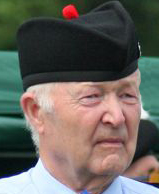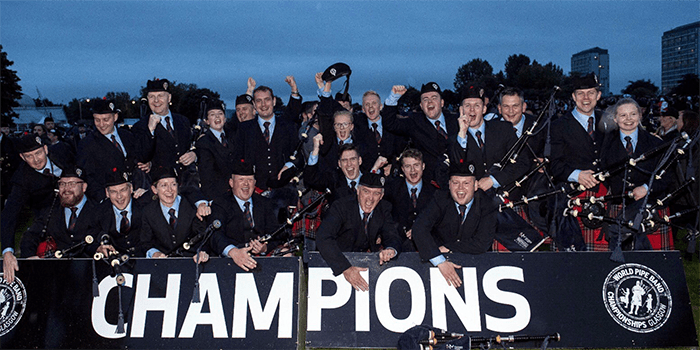
Former RSPBA Adjudicator Alistair Aitken concludes his review, from an ensemble perspective, of the Grade 1 Medley performances at the 2018 World Pipe Band Championships held last Saturday on Glasgow Green.
The Medley competition provided the bands with much more freedom to demonstrate the musical capabilities of the pipe band. Performances these days can be very innovative and exciting. It is sometimes unfortunate that some of the bands tend to favour technical proficiency and dexterity to the overall musical effect.
In some cases compositions come across as finger exercises rather than melodic tunes. Harmonies and counter melodies are so complicated that the original tunes becomes lost in the mix, and long transitions between tunes can be boring and produce little musical impact. I have no doubt that many people will not agree with these comments. I am a strong supporter of technical standards but surely their alignment with collective musical effect between pipes and drum has to be the ultimate aim. Being ultra-critical, my observations on the 12 medley performances are as follows – although overall the standards achieved by all the bands were very high as I anticipated they would be.
Johnstone Pipe Band (11/11/10/12) Overall, an effective grouping of tunes. My impression was that the drummers were rushing in the opening tune. The playing was rather forced and intense. There was a rather long transition to the jigs, which possibly then went on for too long. The piping sound seemed to waver a bit in the slow air and again in the final tune. Overall I thought the snare drummers could have relaxed more to let the different rhythms flow better.
St Laurence O’Toole (6/6/1/2) Another strong performance and a very musical presentation. Once again I thought the snare drum sound was harsh in relation to a nice, sweet piping sound. The jigs were very fluent and musical. The snare drummers seemed to rush a little at the start of the strathspey and at times I felt they were just too dynamic. The piping was solid throughout. I was told later that the Leading Drummer had broken a stick but had managed to replace it without affecting the performance as it happened just before a natural break. Obviously it did not affect the drumming result.
Simon Fraser University (5/5/2/6) The second introductory drum roll was not quite precise enough and a piper started late. Some of the melodies became lost at times in the harmonies. Towards the end the clarity of the piping deteriorated slightly and some phrases seemed a little laboured. The drum corps again was influential musically and the execution was precise. Overall the band performance was not quite as good as in the MSR.
Police Scotland Fife (7/7/4/8) From the off the drumming came through rather dominant at times and in the first part of the opening tune the piping and drumming were not quite integrated. Thereafter the performance settled to precise playing and good musical effect from each of the time signatures. The depth of the piping sound seemed to fall away a little towards the end. Not sure about the interpretation of the Fiddler’s Rally as for me the melodic line did not come through clearly at times.
Inveraray and District (3/4/5/5) The snare drums still projected a slightly hard sound in relation to the piping pitch, but in general the drumming was very influential musically. The snare drummers seemed to push the tempo slightly in the second strathspey; and were again just on the edge at other times. The piping was clear throughout, but for me some of the tunes did not inspire like the band’s other medley. Overall not as good a band performance as the MSR but I thought the drumming placing was rather harsh as in my book this corps was still a strong contender for first place in drumming overall.
Boghall and Bathgate Caledonia (10/10/8/10) The band maintained its good balanced sound between pipes and drums from the MSR performance. The selection of tunes balanced well together and overall they projected an effective and fluent musical presentation. My only significant criticism was that the first few bars of the strathspey came through as a little laboured. The adjudicators were fairly consistent in their results so they must have heard things which could not be heard in the stand.
78th Fraser Highlanders (8/8/7/7) Apart from the first part of the opening tune not quite being integrated between pipes and drums, and a laboured break to the strathspey, I could not identify any major fault with the performance. The overall band effect was musical and rhythmic with a clear portrayal of the different time signatures. The snare drum sound was still a little harsh in relation to the piping pitch.
Shotts and Dykehead Caledonia (4/2/12/4) The first drum roll was not clean and the snare drums still harsh in relation to the pipes. The piping sound was again clear and strong with a well-balanced and resonant drone sound. The second jig and the slow air for me were not as melodic as the others but the execution was clear and well defined. Once again the adjudicator placing for the drumming was rather harsh, particularly in relation to the ensemble placing.
Vale of Atholl (9/9/9/9) The drumming again was rather dominant in relation to the piping. The performance started with a rhythmic and musical opener. The strathspey playing became a shade too controlled and deliberate in places and the reel playing was also controlled. Overall the performance was a good technical demonstration but lacked a bit in musical effect.
Field Marshal Montgomery (1/1/6/1) This proved to be the performance of the day. It was lively, rhythmic, balanced between pipes and drums, exciting, tempos just on the edge and excellent musical effect throughout. A harmonious sound balance with a stereo effect. A clear demonstration of player confidence and technical ability and accuracy; and an example to everyone of what I would regard as optimum pipe band musical ensemble. I could not agree with the 6th placing for drumming. FMM are pictured at the head of this article shortly after their victory was announced.
Scottish Power (2/3/3/3) FMM were a difficult act to follow but another very strong band performance with excellent clarity between pipes and drums. The sound balance and precision of playing were very good. My only real criticisms were that the strathspeys were perhaps just a little over controlled; and towards the end the harmonies were a little too dominant from where I was sitting.
Dowco Triumph Street (12/12/11/11) The performance started well with a rhythmic opening tune and well controlled jigs. The sound quality of the pipes then gradually fell away, a factor possibly being the weather. The slow air also seemed to go on too long. In general the drumming influence on the melodies was good but at times the snare drummers were too dominant.
Conclusions
Perhaps I could finish with a few general comments: Across all the grades, apart from a few anomalies which there always will be, the piping adjudicator placings were fairly consistent. This may reflect the fact that adjudicators now have the opportunity to discuss each performance after they have submitted their critique sheet but before their final placings have been decided. In many instances, however, there were wide differences between drumming and ensemble placings. In my view there should be a close relationship between these two disciplines as both should to a large extent be considering the musical influence of the drumming on the piping.
From personal experience I know that this subject has been explored in the past in great depth as part of RSPBA adjudicator training. I know that some people may not agree with me but it is a pipe band contest and the role of the drumming adjudicator is not just to consider the technical proficiency of the drum corps in isolation, but also to assess the influence of the drumming on the pipers from a musical perspective, including the sound balance. Similarly the ensemble adjudicator should be doing likewise and not concentrating only on the standards of piping.
There could of course be other reasons for the differences in placings. The situation is also not helped by the fact that the adjudicators normally stand in different places – the drumming adjudicator standing behind the drum corps with the piping projecting through the dominating drums, whereas the ensemble adjudicator normally spends most of the time at the head of the band circle where the drumming is projecting through the pipes and the effect can be quite different and much more balanced. Perhaps it is time to consider replacing the drumming adjudicator with a second ensemble adjudicator.
The format of the World Championships has regularly been under debate over the years and it is impossible to please everyone. The weather is one of the factors but it is unlikely that any form of covered arena will ever be available to avoid the dangers of Scotland’s climate. Stormy weather in August is not unexpected as history has shown it to be a regular feature of the Edinburgh International Festival and the Royal Edinburgh Military Tattoo. If the Worlds were to be held during the month of June as they once were that might stand a better chance of good weather but I suspect that is unlikely to happen.
The other factor is the actual format of the World Championships. The Friday is restricted to the Grade 1 qualifiers and often has little atmosphere, although this year there was a better attendance of spectators. The Saturday on the other hand has become very complicated with qualifying heats and finals ranging across Grades 2 to Grade 4. In some grades there were heats when total entries in the grade were less than the previous cut-off point of 24.
Even the Grade 1 competition this year, with 22 bands, could have been run as a single contest, thus allowing all the bands the same competing opportunity. It was also unfortunate that the Grade 1 qualifying heats were unbalanced and as a result some very good bands from the other side of the world did not make the finals. The big question is whether all the heats are really necessary. If pressure for them is coming from the bands might it not be possible for some of the heats in the lower grades to be held on the Friday?
As long as there are qualifying heats for Grade 1 there will be bands disappointed that they have not made the Finals, some which have travelled to Scotland at great cost. It would be nice to see a new competition solely for these bands to give them another challenge rather that hang around spare on the Saturday. Such competitions do exist in other countries.
Lastly, the Grade 2 Final was this year again held in the main arena following the Grade 1 medleys. Before the competition started there was a mass exit of spectators from the main stand. This, for me, was rather discourteous to the Grade 2 finalists. I sat through the whole contest and felt isolated in the main stand! It would have been much better if the Grade 2 Final could have been programmed for the main arena before the start of the Grade 1 medleys so that the main arena finished with the top bands. Whether this could be achieved in future will again be affected by the timing if there are Grade 2 qualifying heats.
All-in-all a very enjoyable experience to hear all the great performances first hand.
[wds id=”2″]
